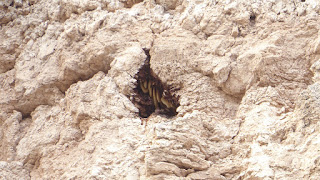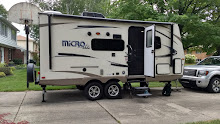Saturday was our final full day at
Lost Dutchman Mine. After watching weather forecasts carefully, and tired of
clouds and cold(for Arizona) temperatures, we decided that Sunday we would go
west to Yuma in hopes of finding a few days of sun, if not warmer temps. Before
leaving, we decided to spend a day driving north on I17 to see some places we
haven’t visited in the past. Nearly two hours north, our first stop was at
Arcosanti, which Marv had discovered in the Day Trip book we had borrowed from
Ken. Italian Architect Paolo Soleri coined the word “Arcology”—a mix of
architecture and ecology--to express his vision of a community in which people
can live and work in harmony with the environment. Appalled by Urban Sprawl, he
designed a prototype city under a single roof, concentrating human activity
into an energy efficient environment while leaving the vast surrounding acreage
natural and undisturbed. His vision was a facility that would house 5000 people
on just 15 acres. It was begun in 1970 and is only 1/10 built today. Soleri and
his wife have both died, and the goal now is to maintain what has been built,
while hoping to add on in the future. Our guide was a Columbian architect who
had lived and worked in Arcosanti for 6 months a few years ago. He finished his
schooling in November and returned to live here for a year, at least, because
he loves it so much. About 75 people live in Arcosanti today, living communally
and carrying on Soleri’s vision. There is a café and a bakery, but most of
their money is made from manufacturing brass bells and ceramic bells using a
molding process developed by Soleri. Money is also made by holding workshops,
seminars, festivals, and performances by visiting artists through the year.
Some people living in Arcosanti have been there for 40 years. New people come
in monthly, staying for varying lengths of time. Only three miles down a dirt
road, it is very removed from the outside world and it is easy to get lost in
the ambiance. Our guide said it is not unusual for him to go a month at a time
without ever returning to the highway or the nearby town.
 |
| This is the entrance to Arcosanti. It looks very industrial. |
 |
They use the same sand casting technique used for the bells to
make silver jewelry, like these earrings. They say that every
design is unique. |
 |
| This is the outdoors workshop area where they cast the bells that they sell. |
 |
The sand casting technique was also used to make this half-dome
roof for one of the community gathering spaces. |
 |
This is the model for the community that Soleri designed.
The angled surface was to be greenhouses down the
hill of the deep, wide wash on which it is situated. |
 |
The outdoor amphitheater is used for festivals and performances.
Running down the center of the seating area is a waterfall which
feeds a small water feature in front of the stage. It only runs for performances. |
 |
| The Community swimming pool is a popular spot on much warmer days, I'm sure. |
 |
This fabric column had a fan at the top, which pushed warm air from the
dome window at the top and heated the Cafe. They take it down in the summer. |
 |
This is one corner of the Cafe, with interesting windows overlooking
the wash and hillsides to the south, letting in lots of light. |
We finally had to leave so we
could go a bit further north to Camp Verde. I17 rises to 4700ft. elevation
before plunging down into the beautiful Verde Valley. We didn’t have time to
visit Fort Verde State Historical Park, which was a regret because they were holding
a Buffalo Soldiers event there. But we decided to go back further in time and
visit Montezuma Castle National Monument. This was another series of Cliff
Dwellings, like the others we had seen, built around 1100CE and abandoned around
1400CE. When it was completed the dwelling contained 19 rooms, some for living
space and some for storage. The Verde River at the bottom, which was used for
irrigating extensive acres of crops by the residents, had flooded violently
from the recent rains and some of the trails are closed because of mud and
debris.
 |
| There was a magnificent view over the valley from a rest area along the way. |
 |
They are protecting Montezuma Castle (a misnomer; Montezuma would never
have been anywhere near here) by leaving it inaccessible to the public. |
 |
| These beams are original, 700 year old Sycamore from the river banks. |
 |
| The flooding two nights before left a lot of damage and debris. |
 |
This lower, undeveloped Castle A demonstrates that there river side was lined with
similar small dwellings resulting in thousands of people living in this common area
and trading with each other as well as others thousands of miles along a trade route. |
 |
| Smaller niches in the cliff may have been used for storage. |
 |
| This small niche nearly at the top of the cliff had a giant bee colony inside it. |
A few miles away is Montezuma Well, a limestone sink formed centuries
ago by a collapsed cavern, with more Sinagua cliff dwellings under the ledge
above the water. Several tribes have creation stories centered on this deep
spring, and there are five species of creatures found only in these waters,
making it a very sacred and very special place.
It was after dark when we
returned to our campsite, to find that the battery hadn’t charged during the
day. We don’t know if it was lack of sun, or an inadequate solar panel, but
it’s a good thing we will be charging tomorrow as we drive to Yuma.
 |
| This shows the extent of the communities that lived all along the river a thousand years and more ago. |
 |
| There were cliff dwellings over the small lake at Montezuma's Well, also. |
 |
The hillsides around the Well are covered with the remains of pueblos
and even older dugout houses. This was a large one that it is assumed
was used as a Community meeting place of some sort. |
 |
Like at Casa Grande, there are thousands of miles of canals
left from the farmers who needed to irrigate their fields
900 years ago. Some are still used by area farmers today.
It boggles the mind what they accomplished with stone age tools. |
 |
| This protected area seems very spiritual still today. |
































































